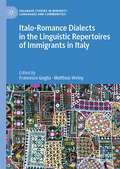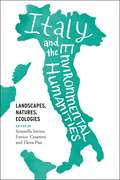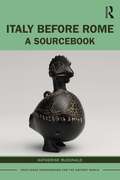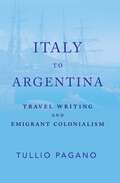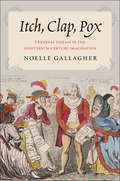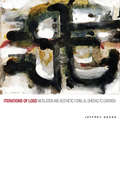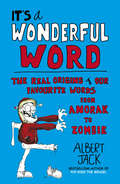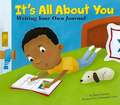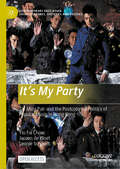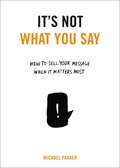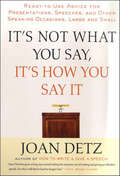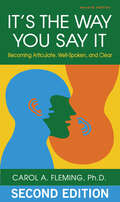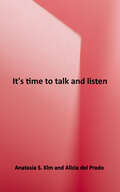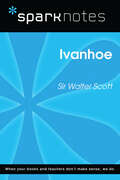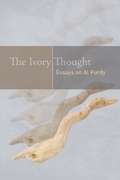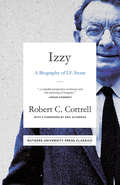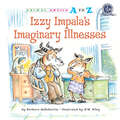- Table View
- List View
Italo-Romance Dialects in the Linguistic Repertoires of Immigrants in Italy (Palgrave Studies in Minority Languages and Communities)
by Francesco Goglia Matthias WolnyThis edited book brings together experts on the sociolinguistics of immigration with a focus on the Italo-Romance dialects. Sociolinguistic research on immigrant communities in Italy has widely studied the acquisition and use of Italian as L2 by first-generation immigrants, the maintenance of immigrant languages and code-switching between Italian and the immigrant languages. However, these studies have mostly ignored or neglected to investigate immigrant speakers’ use of Italo-Romance dialects, their awareness of the sociolinguistic situation of majority and minority languages, and their attitudes towards them. Given the important role of Italo-Romance dialects in everyday communication and as a marker of regional identity, this book aims to fill this gap and understand more about the role that these languages play in the linguistic repertoire of immigrants. This book will be of interest to students and scholars of sociolinguistics, minority languages, multilingualism, migration, and social anthropology.
Italy and the Environmental Humanities: Landscapes, Natures, Ecologies (Under the Sign of Nature: Explorations in Ecocriticism)
by Serenella Iovino, Enrico Cesaretti, and Elena PastBringing together new writing by some of the field’s most compelling voices from the United States and Europe, this is the first book to examine Italy--as a territory of both matter and imagination--through the lens of the environmental humanities. The contributors offer a wide spectrum of approaches--including ecocriticism, film studies, environmental history and sociology, eco-art, and animal and landscape studies--to move past cliché and reimagine Italy as a hybrid, plural, eloquent place. Among the topics investigated are post-seismic rubble and the stratifying geosocial layers of the Anthropocene, the landscape connections in the work of writers such as Calvino and Buzzati, the contaminated fields of the ecomafia’s trafficking, Slow Food’s gastronomy of liberation, poetic birds and historic forests, resident parasites, and nonhuman creatures. At a time when the tension between the local and the global requires that we reconsider our multiple roots and porous place-identities, Italy and the Environmental Humanities builds a creative critical discourse and offers a series of new voices that will enrich not just nationally oriented discussions, but the entire debate on environmental culture. Contributors: Marco Armiero, Royal Institute of Technology at Stockholm * Franco Arminio, Writer, poet, and filmmaker * Patrick Barron, University of Massachusetts * Damiano Benvegnù, Dartmouth College and the Oxford Center for Animal Ethics * Viktor Berberi, University of Minnesota, Morris * Rosi Braidotti, Utrecht University * Luca Bugnone, University of Turin * Enrico Cesaretti, University of Virginia *Almo Farina, University of Urbino * Sophia Maxine Farmer, University of Wisconsin-Madison * Serena Ferrando, Colby College * Tiziano Fratus, Writer, poet, and tree-seeker * Matteo Gilebbi, Duke University * Andrea Hajek, University of Warwick * Marcus Hall, University of Zurich * Serenella Iovino, University of Turin * Andrea Lerda, freelance curator * Roberto Marchesini, Study Center of Posthuman Philosophy in Bologna * Marco Moro, Editor-in-Chief of Edizioni Ambiente, Milan * Elena Past, Wayne State University * Carlo Petrini, Founder of International Slow Food Movement * Ilaria Tabusso Marcyan, Miami University (Ohio)* Monica Seger, College of William and Mary * Pasquale Verdicchio, University of California, San Diego
Italy Before Rome: A Sourcebook (Routledge Sourcebooks for the Ancient World)
by Katherine McDonaldThis book brings together sources translated from a wide variety of ancient languages to showcase the rich history of pre-Roman Italy, including its cultures, politics, trade, languages, writing systems, religious rituals, magical practices, and conflicts. This book allows readers to access diverse sources relating to the history and cultures of pre-Roman Italy. It gathers and translates sources from both Greek and Latin literature and ancient inscriptions in multiple languages and gives commentary to highlight areas of particular interest. The thematic organisation of this sourcebook helps readers to make connections across languages and communities, and showcases the interconnectedness of ancient Italy. This book includes maps, a timeline, and guides to further reading, making it accessible to students and other readers who are new to this subject. Italy Before Rome is aimed at undergraduate and graduate students, including those who have not studied the ancient world before. It is also intended to be useful to researchers approaching this material for the first time, and to university and schoolteachers looking for an overview of early Italian sources.
Italy to Argentina: Travel Writing and Emigrant Colonialism
by Tullio PaganoIn Italy to Argentina: Travel Writing and Emigrant Colonialism, Tullio Pagano examines Italian emigration to Argentina and the Rio de la Plata region through the writings of Italian economists, poets, anthropologists, and political activists from the 1860s to the beginning of World War I. He shows that Italians played an important role in the so-called conquest of the desert, which led to Argentina's economic expansion and the suppression and killing of the remaining indigenous population. Many of the texts he discusses have hardly been studied before: from Paolo Mantegazza’s real and imaginary travel narratives at the time of Italian unification to Gina Lombroso’s descriptions of Brazil, Uruguay, and Argentina in early 1900s. Pagano questions the apparent opposition between diaspora and empire and argues that there was a continuity between the “peaceful conquest” though spontaneous emigration envisioned by Italian liberal intellectuals at the turn of the century and the military colonialism of Italian Nationalists and Fascists. He shows that racist assumptions about Native American and “creole” cultures were present in the work of progressive authors like Edmondo de Amicis, whose writings became enormously popular in Argentina, and anarchist militants and legal scholars like Pietro Gori, who founded the first revolutionary unions in Buenos Aires while remaining dangerously attached to Cesare Lombroso’s theories of atavism and primitivism. The “growl” of Italian emigrants about to land in Argentina, found in Dino Campana’s poem Buenos Aires (1907), echoes throughout Pagano’s book, and encourages the reader to explore the apparent oxymoron of “emigration colonialism” and the role of literature and public media in the formation of our social imaginary. “Italy to Argentina shows meticulous bibliographic work and is attentive to both fundamental and marginal texts in a double task, on the one hand, of textual analysis, and on the other, of rescuing and recovering a corpus forgotten by critics even when it is highly significant. It is, then, a research work that addresses the Italian emigration to Argentina from an original point of view, linking texts that have not been studied or that have not been sufficiently analyzed.” —Fernanda Elisa Bravo Herrera, author of Huellas y recorridos de una utopía: La emigración italiana en la Argentina "From Boccadasse to La Boca. Tullio Pagano complexifies the relationship between ‘diaspora’ and ‘colonialism’ in the context of Italian migration to South America. In six thematic chapters, Pagano explores the thought of authors on and off the canon. Such diverse voices lead the reader to a new approach to the study of emigrant colonialism and creole studies, towards a deeper, more realistic understanding of the ‘conquest of the desert’ that Italian emigrants wanted to perform in Argentina."—Giuseppe Gazzola, Stony Brook University
Itch, Clap, Pox: Venereal Disease in the Eighteenth-Century Imagination
by Noelle GallagherA lively interdisciplinary study of how venereal disease was represented in eighteenth-century British literature and art In eighteenth-century Britain, venereal disease was everywhere and nowhere: while physicians and commentators believed the condition to be widespread, it remained shrouded in secrecy, and was often represented using slang, symbolism, and wordplay. In this book, literary critic Noelle Gallagher explores the cultural significance of the “clap” (gonorrhea), the “pox” (syphilis), and the “itch” (genital scabies) for the development of eighteenth-century British literature and art. As a condition both represented through metaphors and used as a metaphor, venereal disease provided a vehicle for the discussion of cultural anxieties about gender, race, commerce, and immigration. Gallagher highlights four key concepts associated with venereal disease, demonstrating how infection’s symbolic potency was enhanced by its links to elite masculinity, prostitution, foreignness, and facial deformities. Casting light where the sun rarely shines, this study will fascinate anyone interested in the history of literature, art, medicine, and sexuality.
Iterations of Loss: Mutilation and Aesthetic Form, al-Shidyaq to Darwish
by Jeffrey SacksIn a series of exquisite close readings of Arabic and Arab Jewish writing, Jeffrey Sacks considers the relation of poetic statement to individual and collective loss, the dispossession of peoples and languages, and singular events of destruction in the nineteenth, twentieth, and twenty-first centuries. Addressing the work of Mahmoud Darwish, Ahmad Faris al-Shidyaq, Elias Khoury, Edmond Amran El Maleh, Shimon Ballas, and Taha Husayn, Sacks demonstrates the reiterated incursion of loss into the time of life—losses that language declines to mourn. Language occurs as the iteration of loss, confounding its domestication in the form of the monolingual state in the Arabic nineteenth century’s fallout.Reading the late lyric poetry of the Palestinian poet Mahmoud Darwish in relation to the destruction of Palestine in 1948, Sacks reconsiders the nineteenth century Arabic nahda and its relation to colonialism, philology, and the European Enlightenment. He argues that this event is one of catastrophic loss, wherein the past suddenly appears as if it belonged to another time. Reading al-Shidyaq’s al-Saq ‘ala al-saq (1855) and the legacies to which it points in post-1948 writing in Arabic, Hebrew, and French, Sacks underlines a displacement and relocation of the Arabic word adab and its practice, offering a novel contribution to Arabic and Middle East Studies, critical theory, poetics, aesthetics, and comparative literature.Drawing on writings of Jacques Derrida, Walter Benjamin, Avital Ronell, Judith Butler, Theodor Adorno, and Edward W. Said, Iterations of Loss shows that language interrupts its pacification as an event of aesthetic coherency, to suggest that literary comparison does not privilege a renewed giving of sense but gives place to a new sense of relation.
It's a Wonderful Word: The Real Origins of Our Favourite Words
by Albert JackDid you know that an assassin is a hashish-eater and a yokel a country woodpecker? That Dr Mesmer mesmerised patients back to health or that Samuel Pepys enjoyed a good game of handicap? While we're at it, what have spondulics to do with spines or lawyers with avocados?In It's a Wonderful Word, bestselling author Albert Jack collects over 500 of the strangest, funniest-sounding and most delightful words in the English language, and traces them back to their often puzzling origins. While brushing up on your gibberish or gobbledygook, discover why bastards should resent travelling salesmen, why sheets should remain on tenterhooks and why you should never set down a tumbler before finishing your drink.From blotto to bamboozle and from claptrap to quango, Albert Jack's addictive anecdotes bring the world's most colourful language to life and are guaranteed to surprise and entertain.
It's All a Kind of Magic
by Rick DodgsonCounterculture icon and best-selling author of the anti-authoritarian novels One Flew Over the Cuckoo's Nest and Sometimes a Great Notion, Ken Kesey said he was "too young to be a beatnik and too old to be a hippie. " It's All a Kind of Magic is the first biography of Kesey. It reveals a youthful life of brilliance and eccentricity that encompassed wrestling, writing, farming, magic and ventriloquism, CIA-funded experiments with hallucinatory drugs, and a notable cast of characters that would come to include Wallace Stegner, Larry McMurtry, Tom Wolfe, Neal Cassady, Timothy Leary, the Grateful Dead, and Hunter S. Thompson. Based on meticulous research and many interviews with friends and family, Rick Dodgson's biography documents Kesey's early life, from his time growing up in Oregon through his college years, his first drug experiences, and the writing of his most famous books. While a graduate student in creative writing at Stanford University in the late 1950s and early 1960s, Kesey worked the night shift at the Menlo Park Veterans Administration hospital, where he earned extra money taking LSD and other psychedelic drugs for medical studies. Soon he and his bohemian crowd of friends were using the same substances to conduct their own experiments, exploring the frontiers of their minds and testing the boundaries of their society. With the success of One Flew Over the Cuckoo's Nest, Kesey moved to La Honda, California, in the foothills of San Mateo County, creating a scene that Hunter S. Thompson remembered as the "world capital of madness. " There, Kesey and his growing band of Merry Prankster friends began hosting psychedelic parties and living a "hippie" lifestyle before anyone knew what that meant. Tom Wolfe's book The Electric Kool-Aid Acid Test mythologized Kesey's adventures in the 1960s. Illustrated with rarely seen photographs, It's All a Kind of Magic depicts a precocious young man brimming with self-confidence and ambition who-through talent, instinct, and fearless spectacle-made his life into a performance, a wild magic act that electrified American and world culture.
It's All About You: Writing Your Own Journal
by Nancy LoewenReady to build a journal? First, you'll need the right tools. Open this title in the Writer's Toolbox series and discover plenty of tips and tools to get you started. Soon you'll be recording the happy, horrible, and hilarious moments of your life like a pro!
It's Beginning to Look a Lot Like Zombies: A Book of Zombie Christmas Carols
by Michael P. SpradlinThe snow is falling, the holidays are approaching and…It’s Beginning to Look a Lot Like Zombies! This delightfully depraved book of classic Zombie Christmas carols by Michael P. Spradlin is guaranteed to spread Yuletide cheer to all those good boys and ghouls who devoured the monster New York Times bestsellers Pride and Prejudice and Zombies and World War Z, as well as fans of 28 Days Later and Shaun of the Dead. With an introduction by the inimitable Christopher Moore—bestselling author of Bloodsucking Fiends, You Suck, andthe classic “heartwarming tale of Christmas terror” The Stupidest Angel—It’s Beginning to Look a Lot Like Zombies is a great gift for stuffing into a Christmas stocking…provided you remove the bloody severed foot first!
It’s My Party: Tat Ming Pair and the Postcolonial Politics of Popular Music in Hong Kong (Contemporary East Asian Visual Cultures, Societies and Politics)
by Jeroen de Kloet Yiu Fai Chow Leonie SchmidtThis book is unique in focusing on just one band from one city – but the story of Tat Ming Pair, in so many ways, is the story of Hong Kong's recent decades, from the Handover to the Umbrella Movement to 2019's standoff. A comprehensive, theoretically informed study of the sonic history and present of Hong Kong through the prism of Tat Ming Pair, this book will be of interest to cultural studies scholars, scholars of Hong Kong, and those who study the arts in East Asia.This is an open access book.
It's Not What You Say: How to Sell Your Message When It Matters Most
by Michael ParkerNo matter what the speaking challenge is, this inspirational, cleverly illustrated book will help readers perform with passion, power and persuasion—at the top of their game. Whether chasing a job, planning a pitch, giving a speech at a wedding, presenting to one or one thousand people, readers of It's Not What You Say will discover how to: • Use the rule of three to win any audience over • Prepare so you can be yourself – but better • Embrace the unknown and conquer any fear Capturing a life time&’s work in the art of persuasive communication, this powerful book reveals the principles, tools and tricks to help you become a courageous, memorable, stand-out speaker.
It's Not What You Say, It's How You Say It: Ready-to-Use Advice for Presentations, Speeches, and Other Speaking Occasions, Large and Small
by Joan DetzThe renowned speaking coach offers step-by-step advice on how to prepare and deliver speeches that communicate your ideas and win over audiences.Why do some speakers succeed while so many others lose their listeners? After working with top clients for decades, executive speaking coach Joan Detz has the answers. In this engaging and comprehensive book, she presents strategies and tips for speeches, sales presentations, brief remarks, job interviews, Q&A sessions, panels—and virtually any situation that requires something to say.Filled with checklists, tip sheets, self-evaluations, and practical advice on every page, this thorough and invaluable guide takes the mystery out of our most dreaded experience. This book will help you say it better-whether you’re talking to one or one thousand. Topics include:• Organizing your message• Finding terrific research• Mastering humor• Conquering nervousness• Handling technical glitches• Working with other speakers• Measuring your effectiveness• Making the most of your voice• Using body language• Building audience rapport• Tapping the power of persuasion• And more
"It's the Pictures That Got Small": Charles Brackett on Billy Wilder and Hollywood's Golden Age (Film and Culture Series)
by Anthony SlideGolden Age Hollywood screenwriter Charles Brackett was an extremely observant and perceptive chronicler of the entertainment industry during its most exciting years. He is best remembered as the writing partner of director Billy Wilder, who once referred to the pair as "the happiest couple in Hollywood," collaborating on such classics as The Lost Weekend (1945) and Sunset Blvd (1950). In this annotated collection of writings taken from dozens of Brackett's unpublished diaries, leading film historian Anthony Slide clarifies Brackett's critical contribution to Wilder's films and Hollywood history while enriching our knowledge of Wilder's achievements in writing, direction, and style. Brackett's diaries re-create the initial meetings of the talent responsible for Ninotchka (1939), Hold Back the Dawn (1941), Ball of Fire (1941), The Major and the Minor (1942), Five Graves to Cairo (1943), The Lost Weekend, and Sunset Blvd, recounting the breakthrough and breakdowns that ultimately forced these collaborators to part ways. Brackett was also a producer, served as president of the Academy of Motion Picture Arts and Sciences and the Screen Writers Guild, was a drama critic for the New Yorker, and became a member of the exclusive literary club, the Algonquin Round Table. Slide provides a rare, front row seat to the Golden Age dealings of Paramount, Universal, MGM, and RKO and the innovations of legendary theater and literary figures, such as Alfred Lunt, Lynn Fontanne, Edna Ferber, and Dorothy Parker. Through Brackett's keen, witty perspective, the political and creative intrigue at the heart of Hollywood's most significant films comes alive, and readers will recognize their reach in the Hollywood industry today.
It's the Way You Say It: Becoming Articulate, Well-spoken, and Clear
by Carol FlemingSpeak Your Mind Effectively! The best, most direct way to convey your intelligence, expertise, professionalism, and personality to other people is through talking to them. But most people have no idea what they sound like. And even if they do, they don't think they can change it. It's the Way You Say It is a thorough, nuts-and-bolts guide to becoming aware and taking control of how you communicate with others. Dr. Carol Fleming provides detailed advice and scores of exercises for * Understanding how others hear you * Dealing with specific speech problems * Varying your vocal patterns to make your speech more dynamic * Using grammar and vocabulary to increase your clarity and impact * Reinforcing your message with nonverbal cues * Conquering stage fright An entire section of the book focuses on communication issues in the workplace--interviews, presentations, voice mail, and more. Dr. Fleming puts a human face on her advice through vivid before-and-after stories of forty men and women who came to her for help. "No other skills will position you ahead of your competition as much as good speaking and presentation skills. No book approaches the depth and breadth of Dr. Carol Fleming's It's the Way You Say It." --Patricia Fripp, CSP, CPAE, keynote speaker, executive speech coach, and president of Fripp & Associates
It's Time To Talk (and Listen): How to Have Constructive Conversations about Race, Class, Sexuality, Ability and Gender in a Polarized World
by Anatasia S. Kim Alicia Del PradoConversations about controversial topics can be difficult, painful, and emotionally charged. This user-friendly guide will help you engage in effective, compassionate discussions with family, friends, colleagues, and even strangers about race, immigration, gender, marriage equality, sexism, marginalization, and more. <p><p>We talk every day—and we often do it without thinking. But, as you well know, there are some things that are harder to talk about—especially issues pertaining to politics, culture, lifestyle, and diversity. If you’ve ever struggled in a conversation about a “controversial” topic with a loved one, work colleague, or even a stranger, you know exactly how uncomfortable and heated the discussion can become. And even if you are one of the lucky few that expresses themselves eloquently, how do you move beyond mere “lip service” and turn words into actionable change? <p><p>This groundbreaking book will show you how to get to that important next level in difficult conversations, to talk in an authentic and straightforward way about culture and diversity, and to speak from the heart with tools from the head. Using a simple eight-step approach, you’ll learn communication strategies that are supported by research and have been practiced in classrooms, work meetings, therapy sessions, and more. <p><p>We constantly hear about friends and colleagues whose family members are not speaking to each other because of different political opinions, who’ve exchanged words that have mutually offended one another. If silence is one end of the continuum and verbal conflict anchors the other, how do we reach a middle ground? How do we take part in the “in between” spaces where both parties can speak and listen? <p><p>With this book as your guide, you’ll learn to navigate these difficult conversations, and take what you’ve learned beyond the conversation and out into the world—whether it’s through politics, social justice movements, or simply expanding the minds of those around you.
Ivanhoe (SparkNotes Literature Guide Series)
by SparkNotesIvanhoe (SparkNotes Literature Guide) by Walter Scott Making the reading experience fun! Created by Harvard students for students everywhere, SparkNotes is a new breed of study guide: smarter, better, faster. Geared to what today's students need to know, SparkNotes provides: *Chapter-by-chapter analysis *Explanations of key themes, motifs, and symbols *A review quiz and essay topicsLively and accessible, these guides are perfect for late-night studying and writing papers
I've Dibel'd, Now What?
by Susan L. HallShows educators how DIBELS (Dynamic Indicators of Basic Early Literacy Skills) data can contribute to a well-designed curriculum plan for struggling readers.
The Ivory Thought: Essays on Al Purdy (Reappraisals: Canadian Writers)
by Gerald Lynch Shoshannah Ganz Josephene T. M. KealeyIf one poet can be said to be the Canadian poet, that poet is Al Purdy (1918–2000). Numerous eminent scholars and writers have attested to this pre-eminent status. George Bowering described him as “the world’s most Canadian poet” (1970), while Sam Solecki titled his book-length study of Purdy The Last Canadian Poet (1999). In The Ivory Thought: Essays on Al Purdy, a group of seventeen scholars, critics, writers, and educators appraise and reappraise Purdy’s contribution to English literature. They explore Purdy’s continuing significance to contemporary writers; the life he dedicated to literature and the persona he crafted; the influences acting on his development as a poet; the ongoing scholarly projects of editing and publishing his writing; particular poems and individual books of poetry, fiction, and non-fiction; and the larger themes in his work, such as the Canadian North and the predominant importance of place. In addition, two contemporary poets pay tribute with original poems.
$ix-Figure Freelancing: The Writer's Guide to Making More Money
by Kelly James-EngerIs it possible to give up your nine to five job and make more money as a full-time freelancer? Absolutely. Six-Figure Freelancing shows writers how to make the most of the ballooning freelance industry by adopting a business-like approach to their craft, while offering insightful, first-hand advice to help maximize time and profit.* Includes worksheets and templates to assess and establish the best possible business strategy* Advice on time management and repurposing material for multiple markets, as well as how to gain a competitive edge in a growing marketFrom the Trade Paperback edition.
Izzy: A Biography of I. F. Stone
by Robert C. CottrellThis is the classic story of the life and times of I. F. “Izzy” Stone. Robert Cottrell weaves together material from interviews, letters, archival materials, and government documents, and Stone’s own writings to tell the tale of one of the most significant journalists, intellectuals, and political mavericks of the twentieth century. The story of I. F. Stone is the tale of the American left over the course of his lifetime, of liberal and radical ideals which carried such weight throughout the twentieth century, and of journalism of the politically committed variety. Now available in a handsome new Rutgers University Press Classic edition, it is an examination of the life and career of a gregarious yet frequently grumpy loner who became his nation’s foremost radical commentator provides a window through which to examine American radicalism, left-wing journalism, and the evolution of key strands of Western intellectual thought in the twentieth century.
Izzy Impala's Imaginary Illnesses (Animal Antics A to Z)
by Barbara deRubertisIzzy is itching to see her grandpa, Doctor Impala, but he doesn't like to be interrupted. Is an imaginary illness the only way to see Doc?
